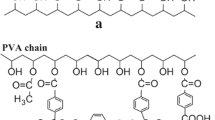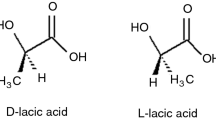Abstract
Hydroxyl terminated polylactide polymers with number of average molecular weights (M n ) varying from 1625 to 3459 g mol−1 were synthesized by ring opening bulk polymerization of lactide in the presence of zinc acetate being a potent catalyst. The use of 1,4 butanediol (BDO) initiator leads to hydroxyl terminated polylactides, thus excellent precursors for shape-memory biodegradable polyurethanes. Different reaction conditions employed for the synthesis of hydroxyl terminated polylactide polymers via activated monomer mechanism may result in differences in M n , percentage mass conversion and percentage degree of crystallinity (%χ c ) of the product. Influence of process parameters, i.e. catalyst concentration, initiator concentration, reaction temperature and time on characteristics of hydroxyl terminated polylactides was studied. These polymers were characterized by Nuclear Magnetic Resonance (1H-NMR) spectroscopy, Fourier transforms infrared (FTIR) spectroscopy, gel permeation chromatography (GPC) and X-ray diffraction (XRD) techniques. FTIR and 1H-NMR confirmed the formation of hydroxyl terminated polylactides. M n was determined by 1H-NMR, GPC and end group analysis. %χ c was calculated from XRD spectra. Maximum mass conversion, M n and %χ c were observed at 5 mol% SnOct2 and 5 mol% BDO concentration. At optimum temperature of 145 °C, these characteristics improved linearly with polymerization time up to 6 h and declined thereafter.








Similar content being viewed by others
References
Zia F, Zia KM, Zuber M, Tabasum S, Rehman S (2016) Heparin based polyurethanes: a state-of-the-art review. Int J Biol Macromol 84:101–111
Chen SH, Tsao CT, Chou HC, Chang CH, Hsu CT, Chuang CN, Wang CK, Hsieh KH (2013) Synthesis of poly (lactic acid)-based polyurethanes. Polym Int 62:1159–1168
Nyambo C, Mohanty AK, Misra M (2011) Effect of maleated compatibilizer on performance of PLA/wheat straw-based green composites. Macromol Mater Eng 296:710–718
Karidi K, Mantourlias T, Seretis A, Pladis P, Kiparissides C (2015) Synthesis of high molecular weight linear and branched polylactides: a comprehensive kinetic investigation. Eur Polym J 72:114–128
Hile DD, Pishko MV (2001) Emulsion copolymerization of D, l-lactide and glycolide in supercritical carbon dioxide. J Polym Sci Part A Polym Chem 39:562–570
Okada M (2002) Chemical syntheses of biodegradable polymers. Prog Polym Sci 27:87–133
Guillaume SM, Kirillov E, Sarazin Y, Carpentier JF (2015) Beyond stereoselectivity, switchable catalysis: some of the last frontier challenges in ring-opening polymerization of cyclic esters. Chemistry A Eur J 21:7988–8003
Gupta AP, Kumar V (2007) New emerging trends in synthetic biodegradable polymers-Polylactide: a critique. Eur Polym J 43:4053–4074
Gowda RR, Chakraborty D (2010) Zinc acetate as a catalyst for the bulk ring opening polymerization of cyclic esters and lactide. J Mol Catal A Chem 333:167–172
Kaitian X, Kozluca A, Denkbas EB, Piskin E (1996) Poly (D, l-lactic acid) homopolymers: synthesis and characterization. Turk J Chem 20:43–53
Murthy NS (2004) Recent developments in polymer characterization using x-ray diffraction. Parameters 18:15–24
Jaffe M, Hammond W, Tolias P, Arinzeh T (2012) Characterization of biomaterials. Woodhead Publishing, England
Monga S, Kaushik A, Gupta B (2016) Synthesis of l-lactide based segmented polyurethanes. Polym Plast Technol Eng 55:943–948
Wang W, Ping P, Chen X, Jing X (2006) Polylactide-based polyurethane and its shape-memory behavior. Eur Polym J 42:1240–1249
Wang W, Ping P, Chen X, Jing X (2007) Shape memory effect of poly (l-lactide) based polyurethanes with different hard segments. Polym Int 56:840–846
Yan B, Gu S, Zhang Y (2013) Polylactide-based thermoplastic shape memory polymer nanocomposites. Eur Polym J 49:366–378
Ivirico JL, Salmeron Sanchez M, Ribelles J, Pradas MM (2009) Poly (l-lactide) networks with tailored water sorption. Colloid Polym Sci 287:671–681
Boua-In K, Chaiyut N, Ksapabutr B (2010) Preparation of polylactide by ring-opening polymerization of lactide. Optoelectron Adv Mater Rapid Commun 4:1404–1407
Sedlarik V, Kucharczyk P, Kasparkova V, Drbohlav J, Salakova A, Saha P (2010) Optimization of the reaction conditions and characterization of l-lactic acid direct polycondensation products catalyzed by a non-metal-based compound. J Appl Polym Sci 116:1597–1602
Sarasua JR, Rodriguez NL, Arraiza AL, Meaurio E (2005) Stereoselective crystallization and specific interactions in polylactides. Macromolecules 38:8362–8371
Bai H, Huang C, Xiu H, Zhang Q, Fu Q (2014) Enhancing mechanical performance of polylactide by tailoring crystal morphology and lamellae orientation with the aid of nucleating agent. Polymer 55:6924–6934
Cabezas LI, Mazarro R, Gracia I, de Lucas A, Rodriguez JF (2013) Optimizing the bulk copolymerization of D, l-lactide and glycolide by response surface methodology. Express Polym Lett 7:886–894
Hyon SH, Jamshidi K, Ikada Y (1997) Synthesis of polylactides with different molecular weights. Biomaterials 18:1503–1508
Amer I (2011) Molecular weight effects on crystallization of polypropylene. University of Stellenbosch, Stellenbosch
Korhonen H, Helminen A, Seppala JV (2001) Synthesis of polylactides in the presence of co-initiators with different numbers of hydroxyl groups. Polymer 42:7541–7549
Fang L, Qi R, Liu L, Juan G, Huang S (2009) Synthesis of poly (l-lactide) via solvothermal method. Int J Polym Sci 2009:1–7
Gupta MC, Deshmukh VG (1982) Thermal oxidative degradation of poly-lactic acid. Colloid Polym Sci 260:514–517
Moon SI, Lee CW, Taniguchi I, Miyamoto M, Kimura Y (2001) Melt/solid polycondensation of l-lactic acid: an alternative route to poly(l-lactic acid) with high molecular weight. Polymer 42:5059–5062
Acknowledgements
This work was financially supported by INSPIRE, Department of Science and Technology, New Delhi with grant no. DST/INSPIRE FELLOWSHIP/2010/341, CSIR, New Delhi with grant no. 22/663/14/EMR-II and Technical Education Quality Improvement Programme-II with Grant No. NPIU/TEQIP-II/FIN/31. We are highly thankful to Dr. Manohar V. Badiger, CSIR-National Chemical Laboratory, Pune for his support in GPC characterization of samples.
Author information
Authors and Affiliations
Corresponding author
Electronic supplementary material
Below is the link to the electronic supplementary material.
289_2017_1991_MOESM1_ESM.tif
Fig. S1 XRD spectra of hydroxyl terminated polylactides keeping molar ratio of LA:BDO fixed, i.e.200:5 for 5 h at 145 °C with varying Zn(OAc)2·2H2O concentration (TIFF 443 kb)
289_2017_1991_MOESM2_ESM.tif
Fig. S2 XRD spectra of hydroxyl terminated polylactides keeping molar ratio of LA:Zn(OAc)2·2H2O fixed, i.e.200:5 for 5 h at 145 °C with varying BDO concentration (TIFF 443 kb)
289_2017_1991_MOESM3_ESM.tif
Fig. S3 XRD spectra of hydroxyl terminated polylactides keeping molar ratio of LA:Zn(OAc)2·2H2O:BDO fixed, i.e.200:5:5 for 5 h with varying reaction temperature (TIFF 443 kb)
289_2017_1991_MOESM4_ESM.tif
Fig. S4 XRD spectra of hydroxyl terminated polylactides keeping molar ratio of LA:Zn(OAc)2·2H2O:BDO fixed, i.e.200:5:5 at 145 °C with varying reaction time (TIFF 443 kb)
289_2017_1991_MOESM5_ESM.tif
Fig. S5 GPC of hydroxyl terminated polylactide with molar ratio of LA:Zn(OAc)2·2H2O:BDO fixed, i.e.100:5:5 at 145 °C for 5 h (TIFF 348 kb)
Rights and permissions
About this article
Cite this article
Monga, S., Kaushik, A. & Gupta, B. Optimization of controlled ring-opening polymerization of l-lactide to hydroxyl terminated polylactides using zinc acetate catalyst. Polym. Bull. 74, 4943–4958 (2017). https://doi.org/10.1007/s00289-017-1991-5
Received:
Revised:
Accepted:
Published:
Issue Date:
DOI: https://doi.org/10.1007/s00289-017-1991-5




